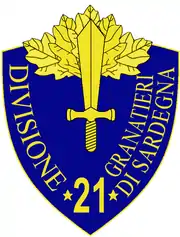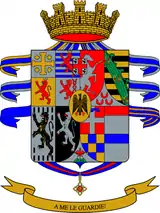21st Infantry Division Granatieri di Sardegna
The 21st Infantry Division Granatieri di Sardegna was an infantry division of the Italian Army during World War II. The Granatieri di Sardegna Division can trace its origins to 1659 when the Duke Carlo Emanuele II of Savoy formed a regiment of Guards. It became a unit in the national army in 1866.
| 21st Infantry Division Granatieri di Sardegna | |
|---|---|
 21st Infantry Division Granatieri di Sardegna Insignia | |
| Active | 1939–1943 |
| Country | |
| Branch | Italian Army |
| Type | Infantry |
| Size | Division |
| Nickname(s) | Granatieri di Sardegna |
| Engagements | World War II |
| Commanders | |
| Notable commanders | General Alfredo Guzzoni |
| Insignia | |
| Granatieri di Sardegna collar insignia |  |
History
On 8 February 1934 the 21st Infantry Division received the name Granatieri di Sardegna (Grenadiers of Sardinia) and consisted of the 1st Regiment "Granatieri di Sardegna", 2nd Regiment "Granatieri di Sardegna", 3rd Regiment "Granatieri di Sardegna" and the 13th Artillery Regiment. In 1939 the 21st Infantry Division Granatieri di Sardegna lost the 3rd Regiment "Granatieri di Sardegna". The division entered World War II with the two Granatieri di Sardegna, the 13th Artillery Regiment and some minor units.
In June 1940, it was mobilized and took part in the invasion of France as a part of the Italian 7th Army reserve in Asti and due to the quick victory in the Battle of France was not involved in any operations.[1]
The division Division Granatieri di Sardegna was transferred to Yugoslavia 8 May 1941 to the Province of Ljubljana and took part in encircling Ljubljana with barbed wire in 1942.[1][2] It was also stationed at Kočevje.[3]
The division moved to Croatia in September, 1942, and back to Rome in the second half of November, 1942 to aid in the defence of the city in case of an Allied attack. During this time the division was reorganized along the lines of the Mod.43 reform of the Italian Army and was augmented with the XXI Mortar Battalion. In total the division fielded 14,500 troops. After the armistice between Italy and Allies of 8 September 1943 the division found itself fighting Italy's former allies the Germans and along with the 12th Infantry Division Sassari and 135th Armored Division Ariete II the Granatieri defended Rome. The Granatieri fought along the Via Ostiensis for two days before falling back to the Porta San Paolo, where the division fought a last stand. There the division was joined by remnants of the Sassari division, the cavalry Regiment "Lancieri di Montebello" (8th) and hundreds of civilian volunteers. The future Italian president Sandro Pertini brought a detachment of Socialist resistance fighters to Porta San Paolo where they received the weapons of fallen grenadiers. Civilians at Porta San Paolo included communist leader Luigi Longo, lawyer Giuliano Vassalli, writer Emilio Lussu, unionist leaders Vincenzo Baldazzi, Mario Zagari, retired Air Force generals Sabato Martelli Castaldi and Roberto Lordi, and 18-year-old future partisan leader Marisa Musu. Around 12:30 the Catholic Communist movement arrived with reinforcements including famed actor Carlo Ninchi. However, by 17:00 the Germans broke the line of the Italian defenders, who had suffered 570 dead. Soon after the Italian military units surrendered to the Germans as the flight of the Italian King Victor Emmanuel III from Rome had made further resistance senseless. However the Italian soldiers handed thousands of weapons over to the civilian population, which was quick to form an organized resistance movement in the city of Rome.
For their role in the defence of the Rome the 1st Granatieri di Sardegna Regiment and the 8th Cavalry Regiment Lancieri di Montebello were awarded with the Gold Medal of Military Valour.
After the surrender of the Granatieri di Sardegna division three autonomous Granatieri battalions based in Corsica refused to surrender to the Germans and along with the 20th Infantry Division "Friuli", 44th Infantry Division "Cremona", 225th Coastal Division, 226th Coastal Division and French Partisans began to fight retreating German troops. The German Sturmbrigade Reichsführer SS and 90th Panzergrenadier Division and the Italian XII Parachute Battalion of the 184th Parachute Regiment,[4] which had come from Sardinia tried to retreat through Corsica towards the harbour of Bastia in the islands north. On 13 September elements of the Free French 4th Moroccan Mountain Division landed in Ajaccio to support the Italian efforts to stop the 30,000 retreating Germans. However the Germans managed to escape.
In spring 1944 the Italian Co-belligerent Army augmented the existing three autonomous Granatieri battalions and raised the "Granatieri di Sardegna" division anew in Sardinia on 15 May 1944. The division consisted of the 1st and 2nd Granatieri regiments, the 32nd Tank Infantry Regiment and 132nd Tank Infantry Regiment, 548th and 553rd Artillery Regiments and an Engineer Company. However it was decided that the infantry units of the division should join the Combat Group "Friuli" on the frontline in Italy. On 31 August the Granatieri division was disbanded with the remaining units used to augment the Combat Group "Cremona".
Commanders
- General Alfredo Guzzoni
- General Carlo Geloso
- General Giovanni Vacchi
- General Ubaldo Soddu
- General Ezio Rossi
- General Umberto Spigo
- General Taddeo Orlando
- General Adolfo De Rienzi
- General Giunio Ruggiero
- General Gioacchino Solinas[1]
Order of battle
 1st Granatieri di Sardegna Infantry Regiment
1st Granatieri di Sardegna Infantry Regiment 2nd Granatieri di Sardegna Infantry Regiment
2nd Granatieri di Sardegna Infantry Regiment 3rd Granatieri Guardie Infantry Regiment
3rd Granatieri Guardie Infantry Regiment 13th Granatieri di Sardegna Artillery Regiment
13th Granatieri di Sardegna Artillery Regiment- 21st Mortar Battalion
- 121st Anti-Tank Company
- 21st Engineer Battalion
- 1st Medical Section
- 161st Motor Transport Section
- 62nd Carabinieri Section[5][nb 1]
C.R.O.W.C.A.S.S.
The names of 4 men attached to the Granatieri di Sardegna Division can be found in the CROWCASS List established by the Anglo-American Allies of the individuals wanted by Yugoslavia for war crimes:
- (Name) ORLANDO Taddeo - (C.R. File Number) 148664 - (Rank, Occupation, Unit, Place and Date of Crime) General, "Granatieri di Sardegna" Div., XI Army Corps (Yugo.) 43 - (Reason wanted) Murder - (Wanted by) Yugo.[7]
- PASQUALE Giuseppe - 253276 - Chief, 21 Bn. Sardinia Gren. Div. Executive Section, Ljubljana (Yugo.) 42 - Misc. crimes - Yugo. [8]
- PERNA U. - 191060 - Commander, Italian Army, 2 "Granatieri di Sardegna", Blocice Slovenia (Yugo.) 25.-28.6.42 - Pillage - Yugo. [9]
- ZANINI - 250586 - Chief, Ex. Off., 21 Bn., Sardinia Gren.-Div., Ljubljana (Yugo.) 42 - Torture - Yugo. [10]
See also
Notes
- Footnotes
- An Italian Infantry Division normally consisted of two Infantry Regiments (three Battalions each), an Artillery Regiment, a Mortar Battalion (two companies), an Anti Tank Company, a Blackshirt Legion of two Battalions was sometimes attached. Each Division had only about 7,000 men, The Infantry and Artillery Regiments contained 1,650 men, the Blackshirt Legion 1,200, each company 150 men.[6]
References
- "21a Divisione di fanteria Granatieri di Sardegna". Retrieved 2009-04-17.
- Vurnik, Blaž (22 April 2016). "Kabinet čudes: Ljubljana v žičnem obroču" [Cabinet of Curiosities: Ljubljana in the Barbed Wire Ring]. Delo.si (in Slovenian).
- "Regio Esercito - Divisione Granatieri di Sardegna". regioesercito.it.
- "Esercito Italiano: Divisione "NEMBO" (184^)". Archived from the original on 2009-05-14. Retrieved 2009-04-19.
- Wendal, Marcus. "Italian Army". Axis History. Retrieved 2009-04-16.
- Paoletti, p. 170.
- The Central Registry of War Criminals and Security Suspects, Consolidated Wanted Lists, Part 2 - Non-Germans only (March 1947), Naval & University Press, Uckfield 2005, p. 68 (facsimile of the original at the National Archives in Kew/London).
- Ibid., p. 69
- Ibid., p. 69
- Ibid., p. 74
Bibliography
- Paoletti, Ciro (2008). A Military History of Italy. Greenwood Publishing Group. ISBN 0-275-98505-9.